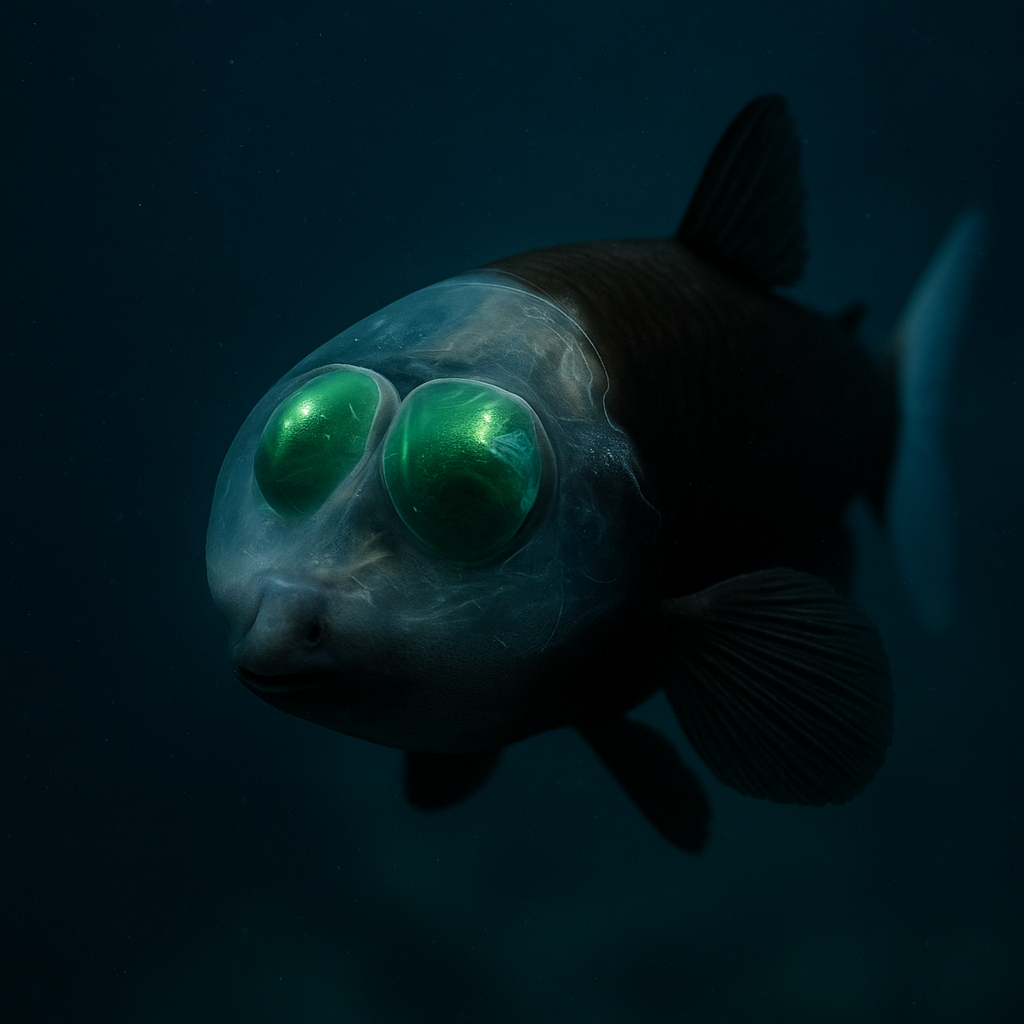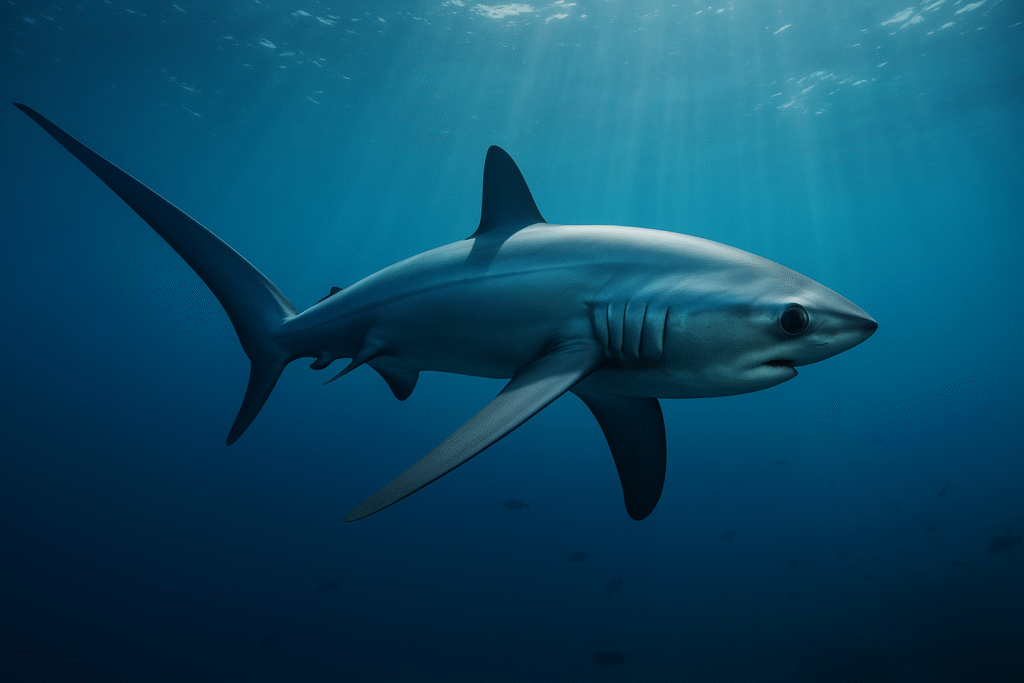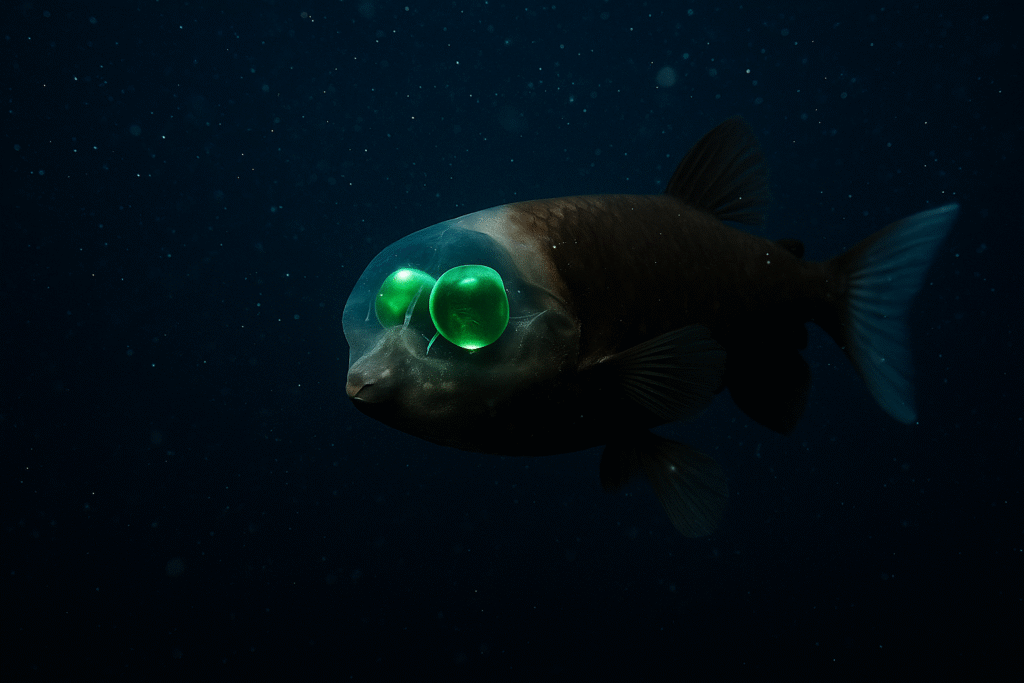In the dark midwaters of Earth’s oceans—what scientists call the mesopelagic, or the twilight zone—exists a creature that seems less like an animal and more like an invention of science fiction. The barrel-eye fish (Macropinna microstoma), first described in 1939, remained shrouded in mystery for decades. Dead specimens dragged up by nets told us almost nothing of its true form, and many believed it to be too fragile to survive intact. It wasn’t until the 2000s, when deep-sea submersibles encountered it alive, that the world finally glimpsed this strange marvel in its unbroken state. What scientists saw stunned them: a fish with a transparent head—a literal window into its brain and tubular green eyes that swivel like periscopes inside a liquid dome.

Anatomy of the Uncanny
The barrel-eye is small, only about 15 cm long, but it compresses extraordinary adaptations into its frame. Its most striking feature is its head: a transparent, fluid-filled shield that encloses the top of the skull. Beneath this clear dome are two glowing green orbs—its eyes—cylindrical and sensitive, perfectly evolved for gathering faint traces of light at depths between 600 and 800 meters. For decades, scientists mistakenly thought the barrel-eye looked forward; in fact, its eyes point straight upward, scanning the silhouettes of prey drifting above. When it wants to feed, the eyes rotate forward, like twin telescopes locking onto their quarry.
Feeding in the Twilight Zone
The twilight zone is a realm of scarcity, and every meal is precious. Barrel-eyes are ambush predators, hovering motionless thanks to their large, horizontal fins that act like stabilizers. They watch quietly for drifting siphonophores—long, colonial jellyfish relatives that stretch for meters like living nets. Within their tangled tentacles lie captured prey: zooplankton, crustaceans, and small fish. The barrel-eye maneuvers with astonishing precision, slipping between the stinging tentacles and stealing trapped prey without harm. Researchers believe its transparent head may serve as a shield against stings, allowing it to raid these lethal nets with impunity.
A Window into Evolution
The barrel-eye embodies the deep sea’s endless creativity. Transparency, rotating eyes, and jellyfish-proof armor might seem bizarre, but they’re perfect solutions to the extreme challenges of mid-ocean survival. In evolutionary terms, it offers a window into how life can take forms that seem utterly alien yet remain grounded in ecological logic. Its adaptations echo an important lesson: survival in hostile environments favors not the strongest, but the most inventive.

Cultural Significance and Symbolism
Though unknown to traditional folklore (since no human culture had encountered it alive until recently), the barrel-eye has rapidly become a symbol of the uncanny hidden in plain sight. Its clear skull has sparked comparisons to glass, ghosts, and even the helmets of astronauts—an apt metaphor, since the deep sea is as foreign to us as outer space. To scientists, the barrel-eye represents both how much we still don’t know about the ocean and how many of Earth’s most spectacular creatures remain invisible just beneath the waves.
Threats in the Deep
The barrel-eye may never face direct human hunting, but the twilight zone it inhabits is under growing pressure. Commercial interest in mesopelagic fishing has risen, with proposals to harvest lanternfish and other deep-dwellers as food and feedstock. Such activity would inevitably affect the fragile balance of life at these depths, including creatures like the barrel-eye. Add to this the increasing disruption of the ocean’s carbon cycle and climate-driven shifts in the marine food web, and the barrel-eye’s continued mystery becomes its vulnerability.

Why It Matters
The barrel-eye is a living emblem of why exploration still matters. Even now, in the 21st century, we are discovering life forms that reframe our sense of what’s possible. Transparent heads, rotating tubular eyes, silent hovering—this is not fantasy but fact, hidden just beyond our view. Protecting the deep sea is not just about preserving biodiversity; it’s about ensuring that such mysteries continue to exist, reminding us that Earth is still a frontier.


Reply